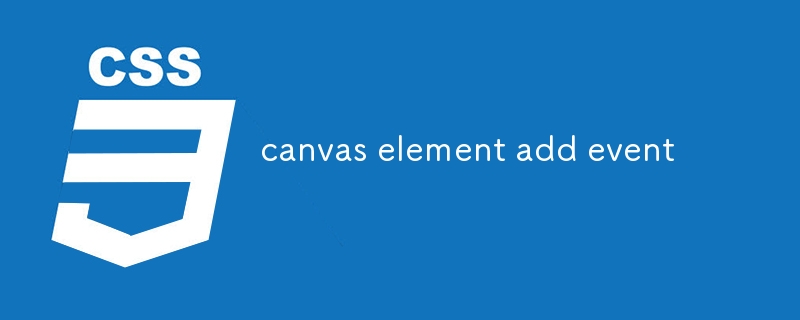
This article provides guidance on event listening for canvas elements in HTML. It describes how to use the addEventListener() method to handle various events, including mouse, keyboard, pointer, drag, touch, and canvas-specific events. Additionally,

How do I listen for events on a canvas element?
You can listen for events on a canvas element using the addEventListener() method. This method takes two arguments: the event type and a function to be executed when the event occurs. For example, the following code listens for the click event on a canvas element:
<code>canvas.addEventListener('click', (event) => {
// Handle click event
});</code>What are the different types of events I can add to a canvas element?
There are a variety of events that you can listen for on a canvas element, including:
click, dblclick, mousedown, mouseup, mousemove, mouseover, mouseout, wheel
keydown, keyup, keypress
pointerdown, pointerup, pointermove, pointerover, pointerout, pointerenter, pointerleave, gotpointercapture, lostpointercapture
drag, dragstart, dragend, dragenter, dragleave, dragover, drop
touchstart, touchend, touchmove, touchcancel
contextmenu, webglcontextlost, webglcontextrestored
How can I capture and process pointer events on a canvas element?
To capture and process pointer events on a canvas element, you can use the requestPointerLock() method. This method takes a single argument, which is the element that you want to capture pointer events for. For example, the following code captures pointer events for a canvas element:
<code>canvas.requestPointerLock();</code>
Once you have captured pointer events, you can listen for them using the addEventListener() method. The following code listens for the pointermove event on a canvas element:
<code>canvas.addEventListener('pointermove', (event) => {
// Handle pointermove event
});</code>Atas ialah kandungan terperinci acara tambah elemen kanvas. Untuk maklumat lanjut, sila ikut artikel berkaitan lain di laman web China PHP!
 Bagaimana untuk mengalih keluar tera air akaun Douyin daripada video yang dimuat turun daripada Douyin
Bagaimana untuk mengalih keluar tera air akaun Douyin daripada video yang dimuat turun daripada Douyin
 Penggunaan modul semula Python
Penggunaan modul semula Python
 Senarai lengkap perintah alter dalam Mysql
Senarai lengkap perintah alter dalam Mysql
 Cara menggunakan mata wang digital
Cara menggunakan mata wang digital
 apa itu enjin carian
apa itu enjin carian
 Kekunci pintasan siap sedia
Kekunci pintasan siap sedia
 js untuk menjana nombor rawak
js untuk menjana nombor rawak
 Pemacu kad bunyi komputer riba HP
Pemacu kad bunyi komputer riba HP




